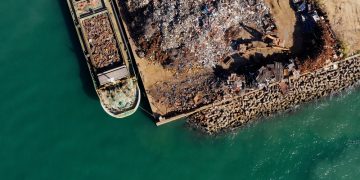Corey Ranslem, CEO of Dryad Global, presents the latest Metis Insights regarding the multiple vessel attacks that have been taking place in the Red Sea by Houthis.
The incidents
The Bahamian flagged M/V Galaxy Leader was the target of a Houthi insurgent hijacking, approximately 50 nautical miles west of Hodeida in the Red Sea on November 19. The 189-metre car carrier, which was transiting empty, was en-route from Körfez, Turkey to Pipavav, India.
The vessel was intercepted by several small fast boats and boarded by uniformed, armed personnel, who rappelled from a Mi-17 helicopter to the deck, and subsequently ordered the crew to alter course to the port of Hodeida. Palestinian and Yemeni flags were later raised aboard, and a video purportedly showcasing the takeover was released.
The vessel had deliberately disabled its AIS prior to the incident, but has since been identified at coordinates 14.9423, 42.89458—corresponding to the Hodeidah anchorage in Yemen. This incident was the first in a series of events within this region as the Houthi’s continue to expand their vessel targeting specifically through the Straits of al-Mandab.
The most recent attack on the AS Strinda, a Norwegian Flagged tanker, demonstrates a rapid escalation in tactics along with the types of vessels being targeted. The AS Strinda was attacked with a missile launched from a Houthi held territory.
Houthi leader’s threat and alleged Israeli ties
The Galaxy Leader incident followed a declaration by Abdul-Malik al-Houthi, the leader of Yemen’s Houthi militia, on November 14. In a televised address on al-Masirah, the group’s satellite TV channel, he emphatically stated their ‘perpetual vigilance’ over Israeli ships in the Red Sea.
Houthi spokesperson Yahya Sare’e later affirmed the seizure’s motivation, alleging Israeli ownership. The vessel’s connection to “Ray Car Carriers,” owned by Israeli businessperson Abraham “Rami” Ungar, was disputed by Israel, classifying the incident as an “Iranian act of terrorism.”
The recent statements by Houthi military spokesperson Yahya Sare’e underscore the seriousness of the threat. Sare’e’s announcement that all ships bound for Israeli ports would be targeted, irrespective of their nationality, if Gaza does not receive necessary food and medicine, reflects a strategic shift in the Houthis’ approach to maritime warfare.
Global consequences and swift condemnation
The Israeli military, in a statement on X, labelled the hijacking of the Galaxy leader as a “very grave incident of global consequence.” Swift condemnation followed from Yemen’s government, the European Union, the United Kingdom, and various Western nations.
Accusations were levelled against the militia for jeopardising international maritime traffic. The crew of 25 individuals are from the Philippines, Ukraine, Bulgaria, and Mexico. None of the crew members are of Israeli origin. The Houthis have said its forces would “deal with the ship’s crew in accordance with the teachings and values of the Islamic religion.”
Subsequent attacks and attempted hijackings by both the Houthi’s and Somali pirates against a wider profile of vessels including military vessels indicate an alarming and escalating trend in the region against ships beyond Israeli ownership. Numerous shipping companies are now considering avoiding this region to a route around the horn of Africa.
However, this route would add significant time and expense to the shipment of goods, along with delays into Mediterranean, Middle Eastern and Asian ports. There are rumours that the JWC (Joint War Committee) at Lloyds is considering expanding the JWC area within this region that will add additional insurance premiums to the already accelerating cost for shipping goods.
Houthi threats and maritime menace
The ongoing Civil War in Yemen has given rise to maritime threats, primarily from the Iranian-backed Houthi forces. Past actions include the successful targeting of the UAE naval transport HVS-2 Swift and attacks on US Navy warships. Comparable boardings have been executed by Iranian forces in the region, raising questions about potential Iranian involvement.
The recent incidents mark a concerning escalation by the Houthis, employing several new tactics which is an unprecedented move. Houthis are also using missiles and drones to conduct attacks on vessels in the region similar to the attack on the AS Strinda. Houthi forces are also targeting vessels via VHF Channel 16 requesting vessels change course to headings that would bring them closer to Yemen.
Expect the boardings, drone, and missile attacks to continue to escalate in this region for the foreseeable future. Along with the drone and missile issues, there have also been numerous reports of small vessels and helicopters sighted on “patrols” within the region which could lead to further threats to shipping.
… predicts Dryad
Commercial shipping dynamics and future scenarios
The hijacking of the Galaxy Leader and subsequent attacks on other vessels underscores the influence of intricate geopolitical dynamics in the Gulf region on commercial shipping. While approximately 1500 vessels transit the Bab Al-Mandeb Strait each month, the recent attacks demonstrate these vessels were specifically targeted due their connections to Israel and Israeli ports.
These incidents reflect an evolution in Houthi capabilities to disrupt merchant shipping, with a potential link to Iranian involvement. Despite calls for measures akin to those used to Somali piracy (e.g. an International Naval Presence, armed security teams on vessels, and Coordination and Information Sharing: International organizations, such as the Contact Group on Piracy off the Coast of Somalia) being deployed in the Red Sea, the appetite for a large-scale intervention in the Red Sea remains uncertain unless the threat continues a drastic escalation.


































































